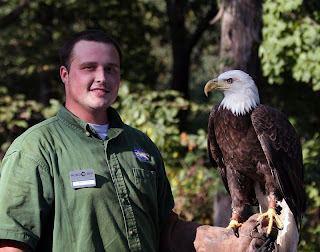Hello everyone. My name is Adam Triska and I am new to the World Bird Sanctuary staff.
This is my first blog entry so I decided to break the ice by telling you my background and how I found my way to the WBS organization.
I am a native St. Louis-an, born and raised in South St. Louis County. The real story started at a very young age for me. Even as a youngster while attending St. Elizabeth of Hungary elementary school in Crestwood my fascination and overall curiosity about nature, particularly animals, was strong. I am often reminded of this by my mother Kelly. She will often tell stories from when I was a boy about the critters I would find and bring back home. She frequently says that I reminded her of the youngest son “Alice” in the movie “Old Yeller”. Oftentimes she truly would have to empty my pockets in search of my findings from my explorations.
As I got older my passion grew stronger and I realized that I wanted to pursue a career with wildlife. It was in 9th grade while attending Lindbergh High School that I found my calling. We had to take a survey that was intended to give us an idea of our skill sets and possible career choices. I knew in my own mind what my skill sets were, and the test confirmed it. The real excitement for me was the career list, and right at the top was Conservation Agent. The job description didn’t sound like work to me—it sounded like an opportunity. I knew from that point on that I wanted to be a conservation Agent when I grew up.
While attending college at Southeast Missouri State University I majored in Wildlife Conservation Biology and Criminal Justice with an emphasis in Law Enforcement—all geared toward my goal of becoming a Conservation Agent.
As I was finishing up my course work for college I began looking for internships that were, frankly, as far away from the Midwest as I could get. However, I was just not catching a break. Then I started looking for something local. That was when I stumbled across the World Bird Sanctuary. The more I looked into it the more I realized that this internship sounded like a perfect match for me.
Upon arrival at WBS my thoughts were confirmed. The staff was friendly and I could tell I was going to love it right from the get go. Working with animals was always a dream of mine and WBS gave me the opportunity to make my dreams a reality. I took full advantage of the opportunity and made myself useful no matter what the task was.
You might be asking yourself why I am at WBS and not pursuing my goal to become a conservation agent. Well, like many others my path has changed for the time being because I can truly say that I love my job and I’m happy where I am.
Submitted by Adam Triska, Field Technician
Photo by Sandra Lowe Murray






















.JPG)


.jpg)

















